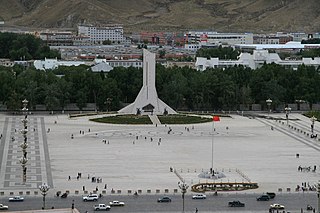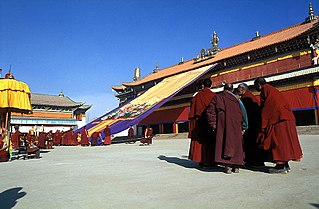
Amdo is one of the three traditional Tibetan regions, the others being U-Tsang in the west and Kham in the east. Ngari in the north-west was incorporated into Ü-Tsang. Amdo is also the birthplace of the 14th Dalai Lama. Amdo encompasses a large area from the Machu to the Drichu (Yangtze). Amdo is mostly coterminous with China's present-day Qinghai province, but also includes small portions of Sichuan and Gansu provinces.

Kyabje Khenchen Jigme Phuntsok,, was a Nyingma lama and Terton from Sertha Region. His family were Tibetan nomads. At the age of five he was recognized "as a reincarnation of Lerab Lingpa. Known also as Nyala Sogyel and Terton Sogyel, Lerab Lingpa was an eclectic and highly influential tantric visionary from the eastern Tibetan area of Nyarong ." He studied Dzogchen at Nubzor Monastery, received novice ordination at 14, and full ordination at 22. In 1980, he founded Larung Gar, the largest Tibetan Buddhist monastic academy.

Larung Gar in the Larung Valley is a community in Sêrtar County of Garzê Tibetan Autonomous Prefecture, in Sichuan, China, known as Kham. Larung Gar is the local name for the community of mostly Tibetan and Han Chinese students which grew around the Serta Larung Five Science Buddhist Academy, founded in 1980 by Kyabje Khenchen Jigme Phuntsok. The residents are monks, nuns, vow holders and lay people. Larung Gar was considered the largest Buddhist monastic center until demolitions by the Chinese government recommenced in July 2016.

Ngawa Tibetan and Qiang Autonomous Prefecture, also known as Aba, is an autonomous prefecture of northwestern Sichuan, bordering Gansu to the north and northeast and Qinghai to the northwest. Its seat is in Barkam, and it has an area of 83,201 km2 (32,124 sq mi). The population was 919,987 in late 2013.

The history of Tibet from 1950 to the present includes the Chinese invasion of Tibet in 1950, and the Battle of Chamdo. Before then, Tibet had been a de facto independent nation. In 1951, Tibetan representatives in Beijing signed the Seventeen-point Agreement under duress, which affirmed China's sovereignty over Tibet while it simultaneously provided for an autonomous administration led by Tibet's spiritual leader, and then-political leader, the 14th Dalai Lama. During the 1959 Tibetan uprising, when Tibetans arose to prevent his possible assassination, the Dalai Lama escaped from Tibet to northern India where he established the Central Tibetan Administration, which rescinded the Seventeen-point Agreement. The majority of Tibet's land mass, including all of U-Tsang and areas of Kham and Amdo, was officially established in 1965 as Tibet Autonomous Region, within China.

The 1959 Tibetan uprising began on 10 March 1959, when a revolt erupted in Lhasa, the capital of Tibet, which had been under the effective control of the People's Republic of China since the Seventeen Point Agreement was reached in 1951. The initial uprising occurred amid general Chinese-Tibetan tensions and in a context of confusion, as Tibetan protestors feared that the Chinese government might arrest the 14th Dalai Lama. The protests were also fuelled by anti-Chinese sentiment and separatism. At first, the uprising consisted of mostly peaceful protests, but clashes quickly erupted and the Chinese People's Liberation Army (PLA) eventually used force to put down the protestors, some of whom had captured arms. The last stages of the uprising included heavy fighting, with high civilian and military losses. The 14th Dalai Lama escaped from Lhasa, while the city was fully retaken by Chinese security forces on 23 March 1959. Thousands were killed during the 1959 uprising, although the exact number is disputed.

The 2008 Tibetan unrest, also referred to as the 2008 Tibetan uprising in Tibetan media, was a series of protests and demonstrations over the Chinese government's treatment and persecution of Tibetans. Protests in Lhasa, the capital of Tibet, by monks and nuns on 10 March have been viewed as the start of the demonstrations. Numerous peaceful protests and demonstrations were held to commemorate the 49th anniversary of the 1959 Tibetan Uprising Day, when the 14th Dalai Lama escaped from Tibet. The protests and demonstrations spread spontaneously to a number of monasteries and throughout the Tibetan plateau, including into counties located outside the designated Tibet Autonomous Region. The arrest of monks at Labrang Monastery increased the tension of the situation. Violence began when Chinese police and People's Liberation Army units used force on non-violent protests by monks and nuns, and spread when protesting Tibetans later clashed with security forces. Clashes also occurred between Tibetans and Chinese Han and Hui residents, resulting in Han and Hui stores and buildings being destroyed and numerous Chinese civilians being injured or killed.

Tibetan Uprising Day, observed on March 10, commemorates the 1959 Tibetan uprising against the presence of the People's Republic of China in Tibet. The failure of the armed rebellion ultimately resulted in a violent crackdown on Tibetan independence movements, and the flight of the Dalai Lama Tenzin Gyatso into exile.

Sinicization of Tibet includes the programs and laws of the Chinese government and the Chinese Communist Party (CCP) which force "cultural unity" in Tibetan areas of China, including the Tibet Autonomous Region and surrounding Tibetan-designated autonomous areas. The efforts are undertaken by China in order to remake Tibetan culture into mainstream Chinese culture.
The 1987–1989 Tibetan unrest was a series of protests and demonstrations that called for Tibetan independence. These protests took place between September 1987 and March 1989 in the Tibet Autonomous Region, in the Tibetan regions of Sichuan, and Qinghai, as well as the Tibetan prefectures in Yunnan and Gansu. Protests began shortly after the Dalai Lama, the religious and temporal leader of Tibet exiled in India since the 1959 Tibetan unrest, proposed a Five Point Peace Plan regarding the “status of Tibet” on September 21, 1987, which was subsequently rejected by the Chinese government. The Plan advocated for greater respect and autonomy of the Tibetan people, and claimed that “Tibet was a fully independent state when the People’s Liberation Army invaded the country in 1949-50.” China rejected the idea of Tibetans as an invaded people, stating that “Tibet is an inalienable part of Chinese territory” and has been for hundreds of years. The Tibetan sovereignty debate is longstanding, and the Tibetan assertion that they are a separate and unique people invaded by China has become a central argument for their independence.
The 2008 Lhasa riots, also referred to as the March 14 riots or March 14 incident in Chinese media, was one of a number of violent protests that took place during the 2008 Tibetan unrest.

Ngawa County, or Aba or Ngaba, is a county in the northwest of Sichuan Province, China. It is under the administration of the Ngawa Tibetan and Qiang Autonomous Prefecture. It is located in the remote northwestern part of the prefecture, on the border with Qinghai and Gansu. The county seat is Ngawa Town.

Sêrtar County or Serthar County is a county in the northwest of Sichuan Province, China, bordering Qinghai province to the north. It is one of the 18 counties under the administration of the Garzê Tibetan Autonomous Prefecture, covering some 9,340 square kilometres. Sêrtar, which means "golden freedom" in Tibetan, lies in the southeast of the Tibetan Plateau and in the historical region of Kham. The vast majority of the population is Tibetan, followed by Han Chinese.
The 2008 Tibetan unrest was a series of protests and demonstrations, met by excessive force, focused on the persecution of Tibetans in the buildup to the 2008 Summer Olympics in Beijing. There was a mixture of outrage and understanding from leading figures abroad.
Human rights in Tibet are a contentious issue. Although the United States advocates and provided funds to Dalai Lama's independence movement, the United States does not recognize Tibet as a country. Reported abuses of human rights in Tibet include restricted freedom of religion, belief, and association; arbitrary arrest; maltreatment in custody, including torture; and forced abortion and sterilization. The status of religion, mainly as it relates to figures who are both religious and political, such as the exile of the 14th Dalai Lama, is a regular object of criticism. Additionally, freedom of the press in China is absent, with Tibet's media tightly controlled by the Chinese leadership, making it difficult to accurately determine the scope of human rights abuses.
The Tibetan Centre for Human Rights and Democracy (TCHRD) is a Tibetan non-governmental nonprofit human rights organization.

The Phuntsog self-immolation incident occurred when a Tibetan Buddhist monk by the name of Rigzin Phuntsog self-immolated on March 16, 2011 in Ngawa County, Ngawa Tibetan and Qiang Autonomous Prefecture, Sichuan province, People's Republic of China. This was followed by another self-immolation incident on September 26, 2011. By March 2012, more than thirty other Tibetans had self-immolated as a protest against Chinese rule of Tibet.

Kirti Gompa, is a Tibetan Buddhist monastery founded in 1472 and located in Ngawa, Sichuan province, in China, but traditionally part of Amdo region. Numerous other associated Kirti monasteries and nunneries are located nearby. As of March 2011, the Kirti Gompa was said to house 2,500 monks. Between 2008 and 2011, mass arrests and patriotic re-education programs by Chinese authorities have targeted the monks, reducing the population substantially to 600 monks. The wave of Tibetan self-immolations began at Kirti Gompa.

Protests and uprisings in Tibet against the government of the People's Republic of China have occurred since 1950, and include the 1959 uprising, the 2008 uprising, and the subsequent self-immolation protests.

As of May 2022, 160 monks, nuns, and ordinary people have self-immolated in Tibet since 27 February 2009, when Tapey, a young monk from Kirti Monastery, set himself on fire in the marketplace in Ngawa City, Ngawa County, Sichuan. According to the International Campaign for Tibet (ICT), "Chinese police have beaten, shot, isolated, and disappeared self-immolators who survived."















